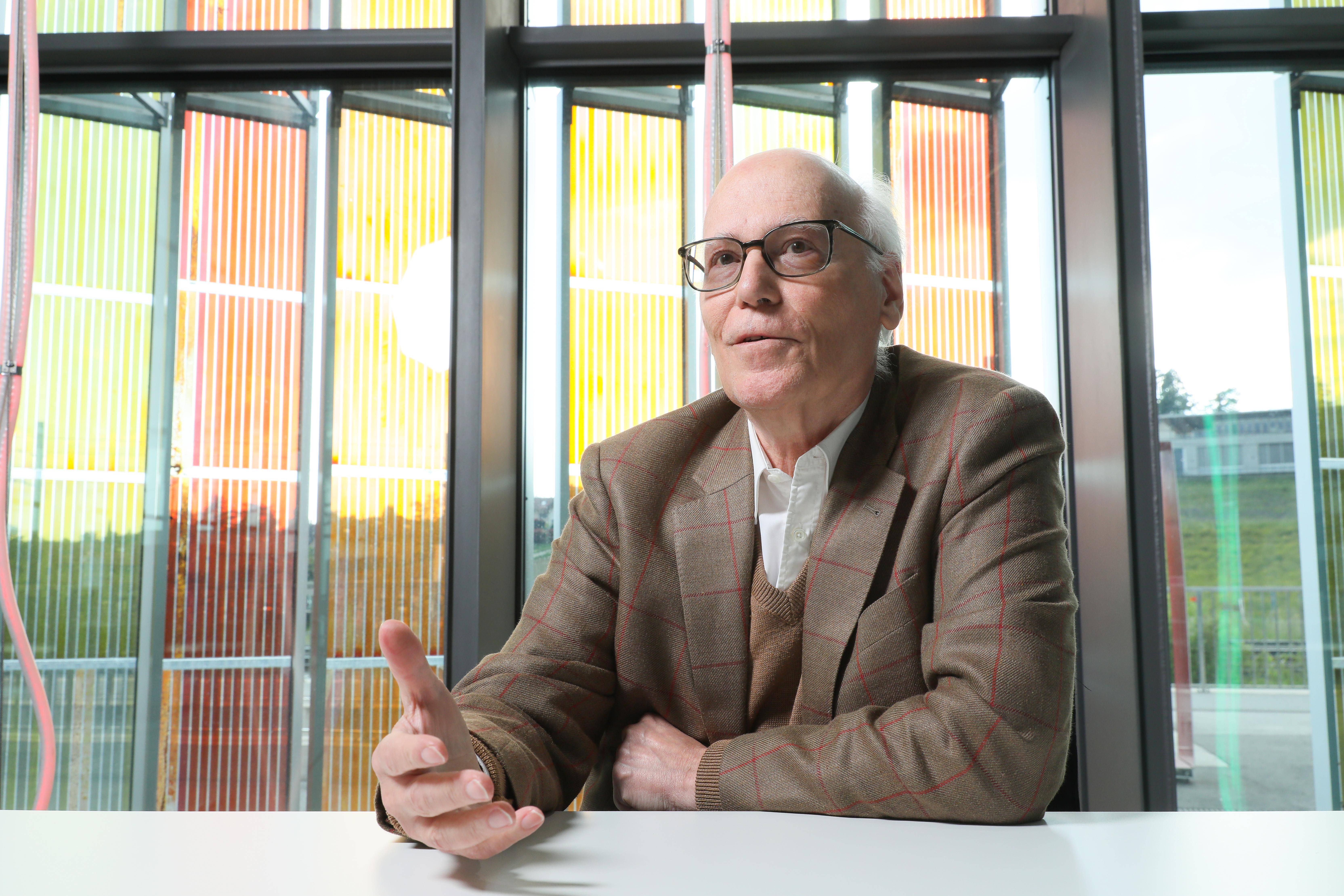Getting to Mars, whatever it takes

©iStock
Sending manned missions to Mars is essential, according to Pierre Brisson, the president of Mars Society Switzerland, “because we can.” We spoke with him about this challenge while he was at EPFL recently to give a talk.
 Pierre Brisson, a planetology enthusiast who heads the Swiss chapter of the Mars Society, believes in the need to send people to Mars. He recently gave a talk at EPFL on the technical challenges we still need to overcome to get to the red planet – the only one he believes we could ever reach – and set up a colony.
Pierre Brisson, a planetology enthusiast who heads the Swiss chapter of the Mars Society, believes in the need to send people to Mars. He recently gave a talk at EPFL on the technical challenges we still need to overcome to get to the red planet – the only one he believes we could ever reach – and set up a colony.
- Why are you so interested in Mars?
I’ve always been passionate about physical geography, planetology and things related to space in general. But what interests me about Mars is that it’s the only planet where we could one day live. And it’s much more interesting than the Moon – a natural satellite whose geological evolution ground to a near halt much earlier.
- Why do you think it’s essential to send humans to Mars?
Because it’s technologically feasible. Maybe not right away, but it will happen one day. What we need to do is develop a massive rocket, like Elon Musk’s Big Falcon. While I doubt people will be able to live permanently on Mars – although that could be our goal – we could at least send manned missions there. And we’ll need to do so because human-assisted robots work much better when humans are around. Sending information between Mars and Earth takes 3–22 minutes each way, meaning direct human control would be impossible unless people are on site. What’s more, no matter how sophisticated our robots are, they can do only what they’ve been programmed to. But humans can react to changing circumstances and modify the robots’ behavior accordingly. Of course, another reason to send people to Mars is the challenge – the thrill of achieving such a major feat. There’s also the issue of the survival of our species. If one day we can no longer live on Earth, our descendants will be glad we started planning now.
- So Mars could be a “Planet B?”
 Yes, eventually. We need to start developing technology now if we want humans to someday be able to live there permanently. It would take a colony around 100 years to become completely self-sufficient; in the beginning, it would be almost entirely dependent on the Earth. That said, Mars does have some key natural resources that could be used almost immediately. Its air contains 95% CO2, which can be processed to extract carbon and oxygen. And the water on Mars could be a source of hydrogen which, when combined with carbon, can generate methane, methanol, ethylene and other important compounds. Finally, the Martian soil was formed from the same types of rocks we have on Earth. That opens up the possibility of producing metals, glass and fertilizer. We’ll need to make as many semi-finished materials as possible on site since sending them up from Earth would be extremely onerous.
Yes, eventually. We need to start developing technology now if we want humans to someday be able to live there permanently. It would take a colony around 100 years to become completely self-sufficient; in the beginning, it would be almost entirely dependent on the Earth. That said, Mars does have some key natural resources that could be used almost immediately. Its air contains 95% CO2, which can be processed to extract carbon and oxygen. And the water on Mars could be a source of hydrogen which, when combined with carbon, can generate methane, methanol, ethylene and other important compounds. Finally, the Martian soil was formed from the same types of rocks we have on Earth. That opens up the possibility of producing metals, glass and fertilizer. We’ll need to make as many semi-finished materials as possible on site since sending them up from Earth would be extremely onerous.
- From what you describe, living on Mars sounds realistic. What do you think the first colonies will be like?
Conditions will be difficult in the beginning. Scientists are already working on various life support systems, such as through the Micro-Ecological Life Support System Alternative (MELISSA) initiative by the European Space Agency (ESA). These life support systems consist of large domes that people will live inside and where almost all of the organic matter they use will be recycled, since organic compounds will be extremely valuable. The biggest challenge will be designing structures that can withstand the large pressure differential between the inside of the domes – humans need, say, 0.5–0.7 bars of pressure to live – and the atmospheric pressure on Mars, which is around 6 millibars on average. That differential will be a huge strain on the dome walls. Possible solutions that scientists are looking at include geodesic hemispheres of around 10–20 meters in diameter that are firmly anchored in the ground – and which would serve as common areas – combined with smaller individual chambers where people would live. These chambers would be connected to each other and made of a steel frame and ultra-thick glass plates. The entire colony would be covered with huge blocks of Martian ice to shield against radiation.
- So people wouldn’t be able to leave the colony?
 Only in space suits, which I imagine would become more comfortable and easier to wear as the technology develops. I’d also like to point out that conditions on Mars are much more amenable to human life than those on the Moon. Mainly because Mars has an atmosphere, even though it is thin. And secondly because the days on Mars last 24 hours and 39 minutes, whereas on the Moon they are equivalent to 14 Earth-days. There’s also the fact that temperature fluctuations are much smaller on Mars – ranging from 20°C during the day to –120°C at night, and that gravity on Mars is closer to what we experience on Earth, meaning people can move more naturally with a body weight that’s more like what they’re used to. Studies have shown that microgravity can affect a body’s vital functions – astronauts on the International Space Station (ISS) have reported lesions on their optical nerves, for instance. Missions to Mars will hopefully be less risky in that regard.
Only in space suits, which I imagine would become more comfortable and easier to wear as the technology develops. I’d also like to point out that conditions on Mars are much more amenable to human life than those on the Moon. Mainly because Mars has an atmosphere, even though it is thin. And secondly because the days on Mars last 24 hours and 39 minutes, whereas on the Moon they are equivalent to 14 Earth-days. There’s also the fact that temperature fluctuations are much smaller on Mars – ranging from 20°C during the day to –120°C at night, and that gravity on Mars is closer to what we experience on Earth, meaning people can move more naturally with a body weight that’s more like what they’re used to. Studies have shown that microgravity can affect a body’s vital functions – astronauts on the International Space Station (ISS) have reported lesions on their optical nerves, for instance. Missions to Mars will hopefully be less risky in that regard.
- But the trip to Mars would be much longer. What are the main challenges there?
First of all, radiation. The level on Mars itself would be manageable, about the same as that on the ISS. But it could be a problem during the six-month trip to the planet, when astronauts would be exposed to different kinds of ionizing particles. They can protect themselves against solar radiation – which consists mainly of protons – by taking refuge in chambers surrounded by water reservoirs when sun storms hit. What’s more dangerous is the small amount of galactic cosmic radiation they will be subject to, made up of high-energy nuclei called HZE ions. They have so much energy that there is currently no material capable of blocking them, and they generate extremely hazardous gamma rays upon impact. The dose of this radiation that astronauts would receive on a trip to Mars is not excessive – but they wouldn’t be able to  tolerate much more. That’s one reason why trips any farther than Mars – say, a several-year trip to one of Jupiter’s moons – wouldn’t be feasible. So in terms of distance, Mars is within reach given our existing technology.
tolerate much more. That’s one reason why trips any farther than Mars – say, a several-year trip to one of Jupiter’s moons – wouldn’t be feasible. So in terms of distance, Mars is within reach given our existing technology.
- Doesn’t that prove humans are too earthbound to travel in space?
It’s true that we evolved on Earth and are designed for it. Scientists still need to study the health effects of an extended stay on Mars. And we aren’t sure that stays beyond one or two orbital periods, which last 26 months each, would be safe – although current research indicates they probably would be. We have a window of opportunity we need to seize. In any case, the exciting things we could learn from shorter manned missions to Mars, around 30 months, would be worth it.